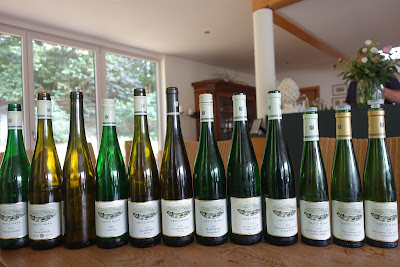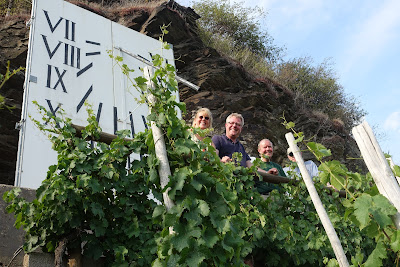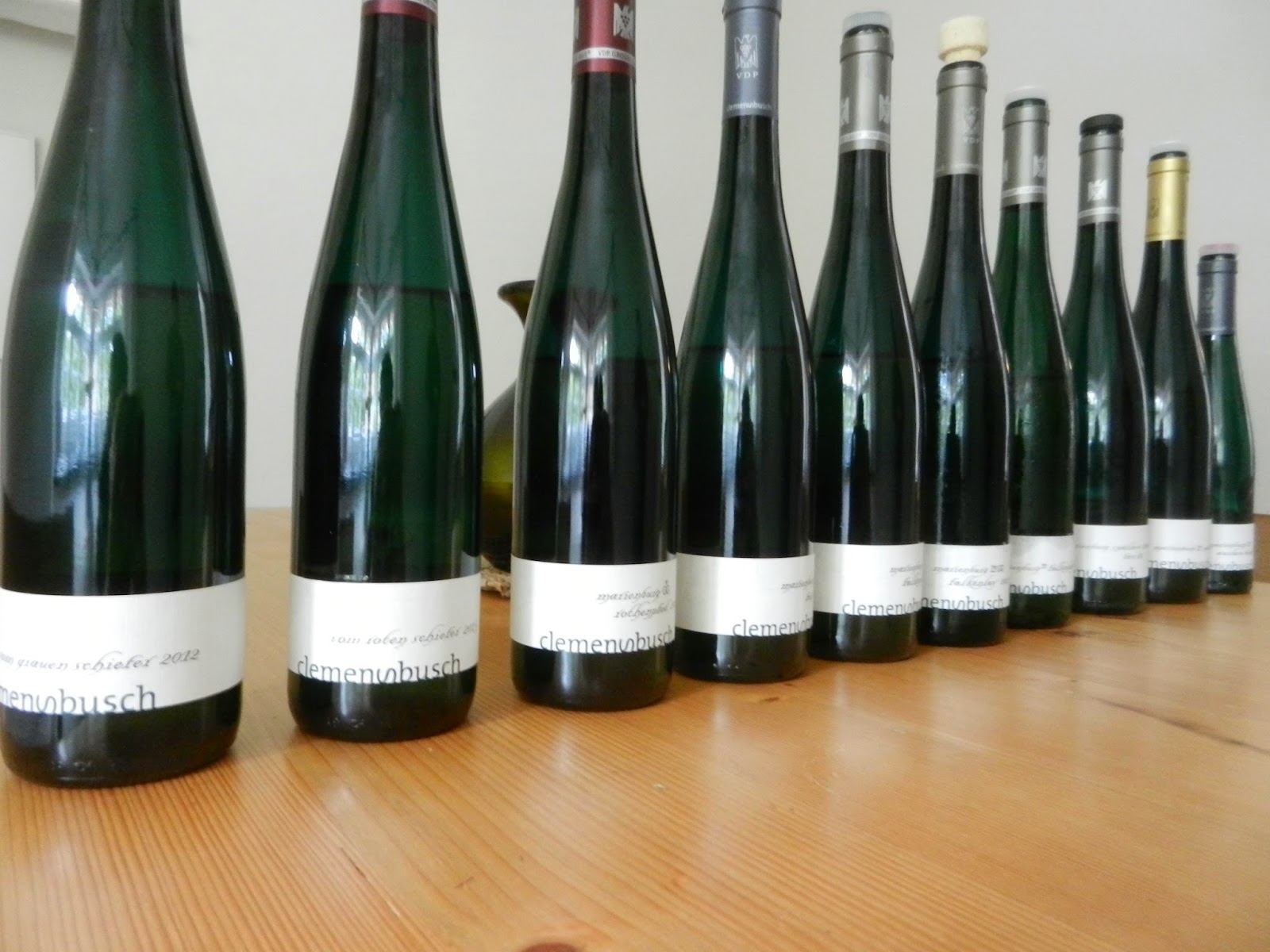Picture:
Cellar Visit, Vineyard Walk and Tasting at Weingut Maximin Grünhaus in Mertersdorf, Ruwer, with Owner Dr. Carl von Schubert – Germany-North
Tour 2017 by ombiasy WineTours
Export of Mosel wines rose sharply in 2021.
We visit the Mosel regularly, on the Germany - North Tour by ombiasy. Below, I am combining the press release regarding the export growth of Mosel wines with pictures of Mosel producers from recent ombiasy tours.
Press Release, Deutsches Weininstitut, March 3 2022
The export of wines with the protected designation of
origin "Mosel" rose sharply in 2021. Exports of Mosel wine recorded a
36.6 percent increase in value last year, while the volume increased by
27.5 percent compared to 2020.
This emerges from the export statistics of the
Association of German Wine Exporters (VDW) in Bonn, as announced by the
Moselwein e.V. in Trier, Germany.
Pictures: In the Vineyard with Gernot Kollmann. See: Tasting and Vineyard Visit at Weingut Immich-Batterieberg in Enkirch, Mosel, with Gernot Kollmann - Germany-North Tour 2017 by ombiasy WineTours
28 Millionen bottles in 100 markets
From January to December 2021, 214,000 hectoliters of
wine with a total value of 90 million euros went from the Mosel cellars
to 100 countries around the world. This corresponds to around 28 million
bottles of 0.75 liters. The average price rose by almost 30 cents per
liter to 4.22 euros from the cellar.
In the previous year, the average price was 3.93 euros
per liter. The information relates to bottled, white quality wines of
the protected designation of origin Mosel up to 13 percent alcohol by
volume. Not included in the statistics are red or rosé wines as well as
country wines or German wines that are produced in the region and
exported.
"After a few difficult years, in which the export of
Mosel wines fell due to low harvest quantities and political problems,
our export companies have reached the level of 2014 again in 2021," says
Ansgar Schmitz, Managing Director of Mosel e.V. Association. At that time, around 214,000 hectoliters of Mosel wine worth 83 million euros were exported.
Pictures: Wine Dinner at Weingut Richard Böcking in Traben-Trarbach, Middle Mosel, with Owner Denman Zirkle - Germany-North Tour 2019 by
ombiasy WineTours: Quintessential Riesling
Lates challenges resolved
In recent years, the punitive tariffs on German wines
introduced by former US President Trump have had a negative impact on
exports. Last but not least, the suspension of these punitive tariffs
led to an increase in exports to the USA of 26.9 percent in value and
21.5 percent in volume in 2021.
The USA is still by far the most important export
market for Mosel wines. With 92,000 hectoliters, 43.1 percent of all
Mosel wines exported in 2021 went to the USA. The US market accounted
for 39.1 percent of the value of exports, with a total of 35 million
euros. The average price was 3.83 euros per liter.
Pictures: Tasting with Markus Molitor at Weingut Markus Molitor in Haus Klosterberg, Mosel - Germany-North Tour 2017 by ombiasy WineTours
China after USA 2nd best on export-statistics
Other countries are becoming increasingly important
for Mosel exports, while the United States' share is steadily shrinking.
China has now become the second most important market for Mosel wines,
although it is still far behind the USA. In 2021, the wine merchants
from the Mosel delivered 12,000 hectoliters worth 7 million euros to
China. This represented a volume increase of 62.9 percent compared to
2020, while the value increased by 55.4 percent. The average price for
China was 5.90 euros per liter from the cellar. In 2021, China pushed
Canada and Norway, where slight decreases in volume were recorded, to
third and fourth place in the export statistics for Mosel wines.
Pictures: At Weingut Fritz Haag, with Oliver Haag. See: Germany-North Tour 2017 by ombiasy WineTours: Quintessential German Riesling and the Northernmost Pinot Noir
Comeback of Mosel wine in Great Britain
Mosel wine experienced an almost sensational comeback
in Great Britain last year. Once a market for inexpensive entry-level
wines, the British now seem to be buying significantly more
higher-quality Rieslings which grapes grow on steep slopes. The value of
exports from the Mosel to the United Kingdom went up by around 180
percent, to a total of 5 million euros. The volume, on the other hand,
grew “only” by 28.5 percent to 800,000 liters. The average price per
liter of wine exported to England was EUR 2.71 in 2020 and rose to EUR
5.91 in 2021. Great Britain thus climbed from 9th place (2020) to 5th
place in the Mosel export statistics.
Pictures: At Weingut Clemens Busch with Rita and Clemens Busch. See:Vineyard Tour and Wine Tasting at Weingut Clemens Busch – Germany-North Tour by ombiasy WineTours (2014)
Upswing in Japan, Scandinavia and The Netherlands as well
Also in Japan (up around 45 percent in value and volume), Sweden (up
28.5 and 20.1 percent respectively), Finland (up 23 and 16.6 percent
respectively) and Denmark (up 39.4 and 24 7%) as well as in The
Netherlands (plus 14.6 and 10.3%), the figures for Mosel wines are
pointing upwards. With their thirst for Riesling, the Scandinavian
countries have been a steadily growing market for Mosel exporters for
years. Exports to these four countries totaled 29,000 hectoliters in
2021. That's more than China, Great Britain and Japan combined.
Two other countries neighboring Germany were also
drivers of the positive development. Importers in Poland bought 167.4
percent more Mosel wine than in 2020, the value increased by 146.6
percent. The increase in Belgium was even greater: 225.2 percent in
value and 177.6 percent in volume. In the Baltic States, the successful
course for wines from Mosel, Saar and Ruwer also continued, especially
in Latvia with an increase of almost 52 percent in value and 42.7
percent in quantity.
Pictures: In the Vineyards. See: Cellar Visit, Vineyard Walk and Tasting at Weingut Maximin Grünhaus in Mertersdorf, Ruwer, with Owner Dr. Carl von Schubert – Germany-North
Tour 2017 by ombiasy WineTours
South Korea and Australia spot Moselwein
Statistically speaking, the Swiss spend almost twice
as much as the British on Mosel wines. For the Confederates, the price
per liter from the cellar was 11.40 euros in 2021. The small neighboring
country recorded an increase in value of 13.3 percent in 2021 and an
increase in volume of 8.5 percent to 2,000 hectoliters, according to VDW
statistics. South Koreans are also increasingly discovering Mosel wine:
the Southeast Asian country also imported 200,000 liters from the
Moselle, 60.6 percent more than in 2020. The value rose by 75.5 percent.
And even the Australians appreciate aromatic Riesling
wines from steep slopes. After all, 100,000 liters went from the Mosel
to "down under" in 2021, at an impressive average price of 8.89 euros
per liter. This makes Australia number 20 in the export statistics for
the Mosel region. Wine from Germany's oldest wine region is delivered to
80 other countries around the world, from Austria to Vietnam, from
Spain to Peru. Exports to countries outside the European Union make up
around 70 percent of Mosel wine exports, and even 75 percent in value.
Pictures: Vineyard Tour with Reinhard Löwenstein, Weingut Heymann-Löwenstein in Winningen, Mosel. See: Vineyard Tour, Cellar Tour and Tasting at Weingut Heymann-Löwenstein in Winningen, Mosel, with Reinhard Löwenstein - Germany-North Tour 2017 by ombiasy WineTours
Ukraine: Mosel estates donate through wine sales
The war in Ukraine and the cost increases for energy, fuel, bottles,
cardboard boxes and containers are currently also causing concern for
export companies in the Mosel wine-growing region and are clouding
expectations for 2022. Ukraine and Russia are not among the most
important export markets for Mosel wine, but both countries (just like
other Eastern European countries) recorded an high percentage increases
in demand in recent years. In 2021, around 1,000 hectoliters of Moselle
wines were delivered to Ukraine and Russia, which corresponds to a total
of around 266,000 bottles (0.75 liter).
Several Mosel estates and wine companies are currently taking part in charity campaigns for the Ukraine.
schiller-wine: Related Postings
Announcement: Ombiasy WineTours in 2022 Summer and Fall
Announcement: 3 Ombiasy Wine Tours in 2022 - Rhône Valley Tour: June 20 - June 29,
Germany South - Alsace: July 01 - July 10, Bordeaux: September 20 -
September 29
Christian Schiller`s SCHILLER-WINE Blog on Corking Wines` Top 101 Wine Writers of 2020 List
German Wine Society Capital Chapter Membership Meeting 2022: Carl Willner Re-elected
President and Christian Schiller Re-elected Vice-president, USA/ Germany
Washington DC Downtown, USA/ Germany
Christian Stahl, Winzerhof Stahl, Franken, Germany back in the USA - Winemaker Dinner at
the Schiller Residence in McLean, Northern Virginia
The Wines of Germany: Presentation by Annette Schiller at the German Embassy in Washington DC/ Consular Conference December 2021
All Sorts of Sparklers: How do the Bubbles get into that Bottle - Presentation by
Annette Schiller, ombiasy WineTours, at the 2021 American Wine Society
National Conference in Atlantic City


















































